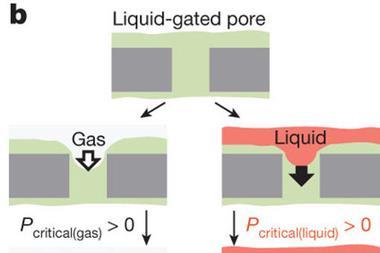Coating micron-scale fibres’ inner surfaces with a MOF membrane could slash propylene production energy consumption

US researchers have made molecular sieving fibres that open up new possibilities for large scale chemical separations that use much less energy than conventional distillation methods. Sankar Nair and his Georgia Institute of Technology team have shown their metal–organic framework (MOF)-lined fibres can perform similarly to distillation in separating propylene and propane. That’s the same post-cracking raw mixture that the majority of the 77 million tonnes of propylene produced in 2011 was distilled from. ‘The degree of separation by the membrane is comparable, but uses vastly less energy,’ Nair says.
Though scientists recognise MOF membranes’ separation potential, they’ve mostly been fabricated on large tubes, whose surface area-to-volume ratio is too low for producing cheap separation modules. Micron-scale fibres would be better, but inside them conditions for successful membrane formation change significantly, Nair explains. ‘The amount of reactant present in the fibre is miniscule, and molecular transport and reaction processes are quite different,’ he says.
The Georgia Tech team’s new approach uses two solutions – one containing zinc ions and another containing methyl imidazole. With one solution inside 250µm diameter hollow poly(amide-imide) porous fibres and another outside them, they start forming a zeolitic imidazolite framework (ZIF) where the two meet. They initially explored conditions where the solution inside the fibre didn’t move, but got patchy coatings. When they realised this setup wasn’t supplying enough reactant, they pumped the inner solution through the fibre, getting better coatings but struggling to control thickness and quality. Finally, they devised an intermittent approach, allowing the membrane to grow under static conditions, then periodically replenishing the reactant supply.
This lets Nair’s team direct film growth inside the fibre or on its inner or outer surfaces through different reagent and solvent permutations. Using tiny pores in MOF films inside the bore of the fibres as selective molecular scale sieves they then separated hydrogen or propylene from propane. ‘We have a demonstrated path to “scale down” MOF membranes to hollow fibres, in a manner that we can now look to “scale up” by an in-parallel replication of the process to many fibres bundled together into a module,’ Nair explains.
Zhiping Lai, a chemical engineer from the King Abdullah University of Science and Technology in Saudi Arabia, says this result ‘beautifully demonstrates’ that ZIF-8 membranes can be produced in bulk quantities on cheap supports. ‘Replacing distillation by an efficient membrane process can cut energy use up to 80%,’ Lai says. ‘It significantly increases the economic viability of the membrane process, which may lead to a technical revolution in the chemical industry.’
References
A J Brown et al, Science, 2014, 345, 72 (DOI: 10.1126/science.1251181)












No comments yet